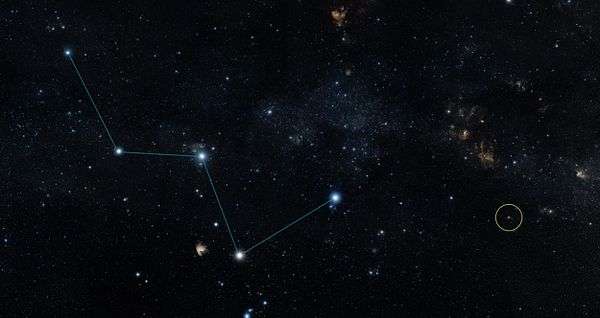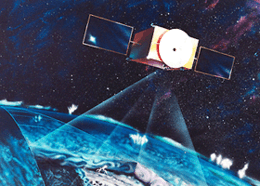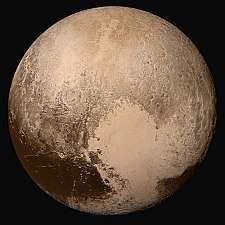HD 219134 f
| Exoplanet | List of exoplanets | |
|---|---|---|
| Parent star | ||
| Star | HR 8832 | |
| Constellation | Cassiopeia | |
| Right ascension | (α) | 23h 13m 16.97632s |
| Declination | (δ) | +57° 10′ 06.0823″ |
| Apparent magnitude | (mV) | 5.574 |
| Distance | 21.25 ly (6.52 pc) | |
| Spectral type | K3 V | |
| Temperature | (T) | 4710 K |
| Orbital elements | ||
| Semi-major axis | (a) | 0.1463 (± 0.0018)[1] 0.14574 (± 2e-05)[2] AU |
| Periastron | (q) | 0.1246 (± 0.00908) AU |
| Apastron | (Q) | 0.1679 (± 0.00908) AU |
| Eccentricity | (e) | 0.148 (± 0.047)[1] |
| Orbital period | (P) | 22.805 (± 0.005)[1] d |
| Inclination | (i) | ?[1]° |
| Physical characteristics | ||
| Mass | (m) | >7.30 (± 0.40)[1] M⊕ |
| Radius | (r) | >1.31 (± 0.02)[1] R⊕ |
| Stellar flux | (F⊙) | 12.38 (± 0.38)[3] ⊕ |
| Density | (ρ) | <17.9 g cm−3 |
| Surface gravity | (g) | <4.25 g |
| Temperature | (T) | 522.6 K (249.5 °C; 481.0 °F) |
| Discovery information | ||
| Discovery date | 2015 November 17 | |
| Discoverer(s) | ||
| Discovery method | radial velocity method | |
| Discovery status | Published | |
HD 219134 f, also known as HR 8832 f, is an exoplanet orbiting around the K-type star HR 8832 in the constellation of Cassiopeia. It is a Super-Earth with a minimum mass of over 7 times that of Earth. Unlike HD 219134 b it has not been observed by the Spitzer telescope and thus its radius and density are unknown. Only a minimum radius can be given.
Characteristics
Mass, Radius, and Temperature
HD 219134 f is known as a Super-Earth, a planet that's more massive than Earth but less massive than Uranus or Neptune. However, because it is not known to transit its star, only the minimum mass can be determined. The planet is at least 7.30 M⊕, indicating that it could be anything from a dense rocky planet to a low-density ice giant. Gillon et al. gives the planet a minimum radius of about 1.31 R⊕, which would result in an almost impossible density. For a more likely mixed composition of rock, water, and hydrogen, HD 219134 f would have a radius closer to about 2.10 R⊕.
Being close to its star, HD 219134 f is hot, with an equilibrium temperature of 522.6 K (249.5 °C; 481.0 °F). Therefore, if a rocky planet, it is too hot for liquid water. It receives about 12 times the stellar flux as Earth.
Orbit
HD 219134 f has an orbital period lasting about 22.72 days, only about a quarter of Mercury's, which lasts about 88 days. The planet also has an orbital radius, or semi-major axis, of 0.146 AU. For comparison, Mercury orbits at 0.38 AU, and Earth at 1 AU. Because of this close proximity, HD 219134 f is likely tidally locked. The planet is near a 1:3 resonance with HD 219134 c and a 2:1 resonance with HD 219134 d.
Host Star
The planet HD 219134 f orbits the K3V orange dwarf HD 219134, also known as HR 8832. It is 79% the radius and 80% the mass of the Sun with 28% the luminosity. It has a temperature of 4699 K and is around 12.5 billion years old or less. For comparison, the Sun has a temperature of 5778 K and is 4.55 billion years old.
The apparent magnitude of the star, or how bright it appears from Earth, is around 5. Therefore, it is only just visible to the unaided eye.
References
- 1 2 3 4 5 6 "HD 219134". exoplanetarchive.ipac.caltech.edu. Retrieved 2017-12-24.
- ↑ "HD 219134 f". exoplanetarchive.ipac.caltech.edu. Retrieved 2017-12-24.
- ↑ Gillon, Michaël; et al. (2017). "Two massive rocky planets transiting a K-dwarf 6.5 parsecs away". Nature Astronomy. 1. 0056. arXiv:1703.01430. Bibcode:2017NatAs...1E..56G. doi:10.1038/s41550-017-0056.



